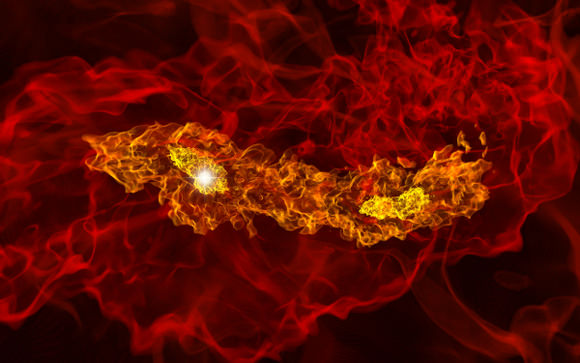[/caption]
Most stars exist in binary pairs today — and new research indicates that may have been true for a very long time. This simulation of a primordial star forming region about 200 million years after the Big Bang shows two pre-stellar cores of more than five times the mass of the sun each. The cores formed at a separation of 800 times the distance from the Earth to the Sun, and are expected to evolve into a binary star system.
Most previous simulations of the early universe, in which clouds of primordial gas collapsed to form the first luminous objects, suggest that early stars formed separately from each other.
Lead author Matthew Turk, of Stanford University, and his colleagues performed computer simulations during which a central clump of primordial material about 50 times the mass of the Sun breaks into two cores with a mass ratio of two to one. Both are able to cool and plump up, by accreting matter from the surrounding cold gas reservoir, “and will likely form a binary star system,” the authors write.
The findings may also have implications for detecting both gravity waves — disturbances predicted by general relativity, which haven’t yet been detected directly — and the ultra-energetic explosions known as gamma ray bursts, since binary systems are thought to be at the origins of both of these phenomena.
The results are in this week’s issue of the journal Science and appear online today at the Science Express website.
Image credit: © Science/AAAS
Source: Science, via Eurekalert.


Gravitational waves, not ‘gravity waves’, please.
Gravity waves are, for instance, ripples in water.
@ Manu,
Ditto! Gravity wave.
These are the Pop III stars discussed earlier. These will be hard to detect.
Gravity waves, in the old term, involve waves which exist in a medium with an Earth gravity of force. Gravitational waves are the components of curvature which are determined by four dimensions, or the one dimension larger than 3. Three dimensional spacetime has no gravitational radiation.
I am not sure how gravitational waves come into this picture. In post Newtonain approximation these waves would be pretty weak. It really takes major events, such as black hole collisions and the like, to detect gravtational radiation across intergalactic or cosmic distances.
These Pop III stars will be hard to detect.
Lawrence B. Crowell
The link to gravitational waves are that large pop III stars will age and go supernovae, and some of them leave black holes (actually the suggested hugely massive 250+Msun stars will definitely leave black holes with current theory)
Solo black holes will be ‘solo’
Paired black holes will approach eachother under the increased emitting of gravitational waves
So whether initial pop III stars are created in solitude or in pairs is an important question.
All according to theory ofc…
I suppose that if two black holes coalesce that this would be a gravity wave engine. The current LIGO is sensitivie to detect stellar mass BH collisions out the 500Mly. These collision are maybe within the sensitivity of gravty wave interferometers.